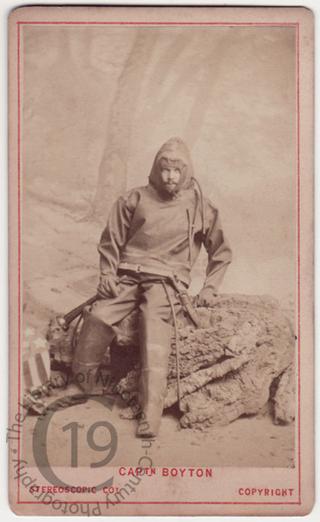
Captain Paul Boyton
The British Biographical Index describes Captain Boyton as an ‘autobiographer’ and ‘aquatic entertainer,’ but he was much more than that, as the following extract from a nineteenth century Dictionary of Biography makes clear. The account of his life reads like one long Boy’s Own adventure story, encompassing as it does the American Civil War, revolution in Mexico, the Franco-Prussian War, the diamond fields of South Africa, and active service in the Peruvian Torpedo Service, quite apart from his exploits as a swimmer, a lifeguard and a submariner.
Paul Boyton was born in Pittsburg on 29 June 1848. 'From his youth he showed fondness for aquatic sports, and entered the American Navy in 1864, serving until the close of the Civil War. He then turned to submarine diving for several years, and during the revolution in Sonora, Mexico, served under General Pedro Martinez. From 1867 to 1869 he was connected with the life-saving service on the Atlantic Coast, where he saved seventy-one lives. In 1870-71 he served in the Franco-Prussian War with the Franc-tireurs after which he visited the diamond fields of South Africa. He then re-entered the life-saving service, where he remained until after his famous leap from a vessel off the coast of Ireland in 1874. This feat was accomplished in a rubber suit of his own invention, during a furious gale. After remaining nearly seven hours in the water, traversing a distance of forty miles, he reached the land. His dress, which is manufactured from the finest vulcanized rubber, is divided into two parts, the junction being at the waist. The only part of the body exposed is the face. He has achieved a world-wide reputation for his exploits, among which are his crossing the English Channel in twenty-four hours on May 28th, 1875. In October of the same year he paddled on the Rhine, from Basle, Switzerland, to Cologne, Germany, 430 miles. Early in 1876 he made the run from Alton, Illinois, to St. Louis, Missouri, on the Mississippi, and from the Bayou Goula to New Orleans, Louisiana.
‘In May, 1876, he was again in Europe, and made the descent of the Danube from Lintz, Austria, to Budapest, Hungary, 460 miles, in six days. He remained in Europe until November, 1878, navigating the important rivers of the Continent, passed through the canals of Venice, and crossed the Straits of Gibraltar. Among his important American trips is the voyage from Oil City, Pennsylvania, to the Gulf of Mexico, 2342 miles, made in eighty days. In August, 1879, he crossed from Long Branch to Manhattan Beach, and in November made the descent of Connecticut River from Canada to Long Island Sound. During 1880-81 he was commander of the Peruvian Torpedo Service. He was captured by the Chileans, and his execution ordered, but he managed to escape to the coast, and was picked up by a vessel bound north. His longest voyage, over 3580 miles, was made from the mouth of Cedar Creek, Montana Territory, starting on September 17th, 1881, to St. Louis, Missouri, reaching there on November 20th. He has travelled through the United States giving exhibitions of his feats. For two years he organised entertainments at Earl’s Court, London. An account of his adventures has been published in Roughing It in Rubber (1886).’
[Pratt, A.T.C. People of the Period 2 volumes, 1897.]
Photographed by the London Stereoscopic and Photographic Company.
Code: 123797




